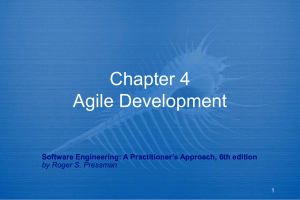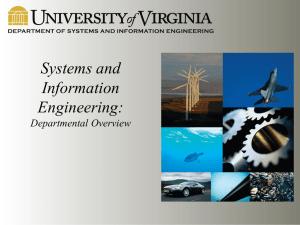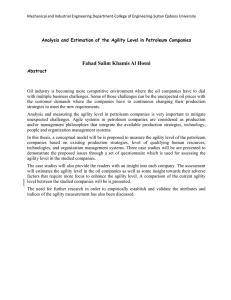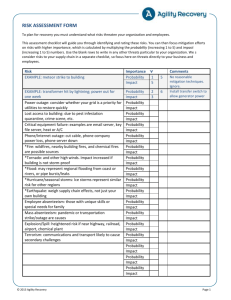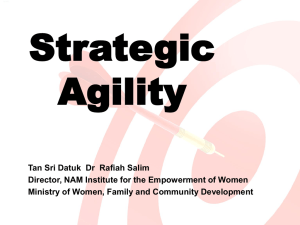Research Journal of Applied Sciences, Engineering and Technology 5(16): 4195-4199,... ISSN: 2040-7459; e-ISSN: 2040-7467
advertisement
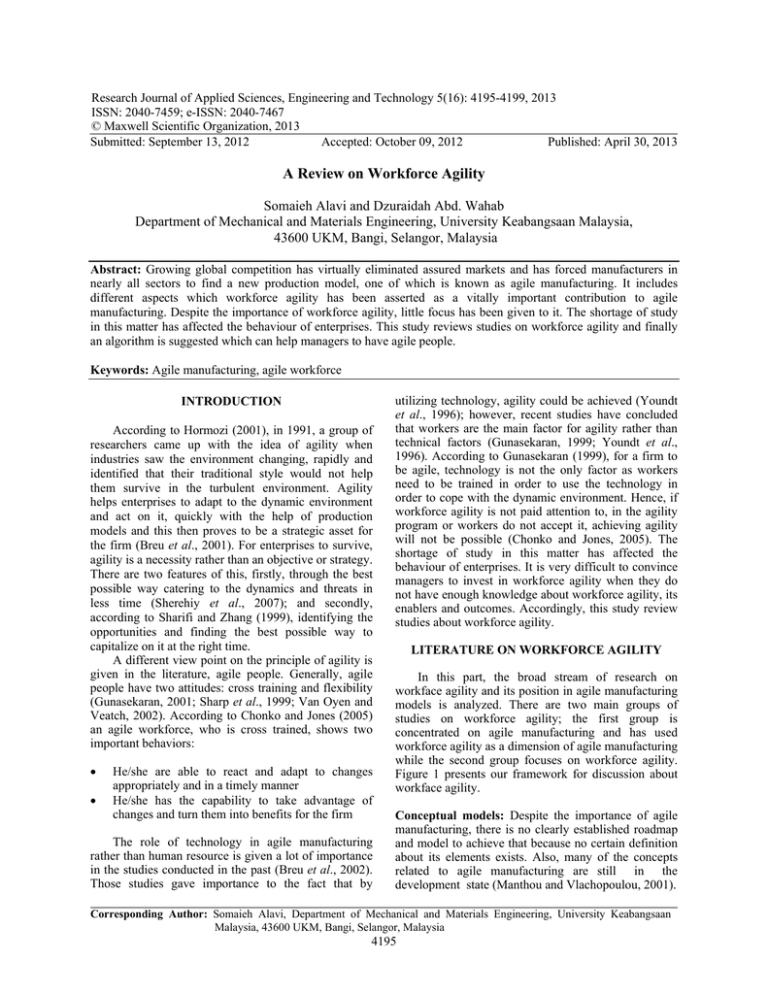
Research Journal of Applied Sciences, Engineering and Technology 5(16): 4195-4199, 2013 ISSN: 2040-7459; e-ISSN: 2040-7467 © Maxwell Scientific Organization, 2013 Submitted: September 13, 2012 Accepted: October 09, 2012 Published: April 30, 2013 A Review on Workforce Agility Somaieh Alavi and Dzuraidah Abd. Wahab Department of Mechanical and Materials Engineering, University Keabangsaan Malaysia, 43600 UKM, Bangi, Selangor, Malaysia Abstract: Growing global competition has virtually eliminated assured markets and has forced manufacturers in nearly all sectors to find a new production model, one of which is known as agile manufacturing. It includes different aspects which workforce agility has been asserted as a vitally important contribution to agile manufacturing. Despite the importance of workforce agility, little focus has been given to it. The shortage of study in this matter has affected the behaviour of enterprises. This study reviews studies on workforce agility and finally an algorithm is suggested which can help managers to have agile people. Keywords: Agile manufacturing, agile workforce INTRODUCTION According to Hormozi (2001), in 1991, a group of researchers came up with the idea of agility when industries saw the environment changing, rapidly and identified that their traditional style would not help them survive in the turbulent environment. Agility helps enterprises to adapt to the dynamic environment and act on it, quickly with the help of production models and this then proves to be a strategic asset for the firm (Breu et al., 2001). For enterprises to survive, agility is a necessity rather than an objective or strategy. There are two features of this, firstly, through the best possible way catering to the dynamics and threats in less time (Sherehiy et al., 2007); and secondly, according to Sharifi and Zhang (1999), identifying the opportunities and finding the best possible way to capitalize on it at the right time. A different view point on the principle of agility is given in the literature, agile people. Generally, agile people have two attitudes: cross training and flexibility (Gunasekaran, 2001; Sharp et al., 1999; Van Oyen and Veatch, 2002). According to Chonko and Jones (2005) an agile workforce, who is cross trained, shows two important behaviors: He/she are able to react and adapt to changes appropriately and in a timely manner He/she has the capability to take advantage of changes and turn them into benefits for the firm The role of technology in agile manufacturing rather than human resource is given a lot of importance in the studies conducted in the past (Breu et al., 2002). Those studies gave importance to the fact that by utilizing technology, agility could be achieved (Youndt et al., 1996); however, recent studies have concluded that workers are the main factor for agility rather than technical factors (Gunasekaran, 1999; Youndt et al., 1996). According to Gunasekaran (1999), for a firm to be agile, technology is not the only factor as workers need to be trained in order to use the technology in order to cope with the dynamic environment. Hence, if workforce agility is not paid attention to, in the agility program or workers do not accept it, achieving agility will not be possible (Chonko and Jones, 2005). The shortage of study in this matter has affected the behaviour of enterprises. It is very difficult to convince managers to invest in workforce agility when they do not have enough knowledge about workforce agility, its enablers and outcomes. Accordingly, this study review studies about workforce agility. LITERATURE ON WORKFORCE AGILITY In this part, the broad stream of research on workface agility and its position in agile manufacturing models is analyzed. There are two main groups of studies on workforce agility; the first group is concentrated on agile manufacturing and has used workforce agility as a dimension of agile manufacturing while the second group focuses on workforce agility. Figure 1 presents our framework for discussion about workface agility. Conceptual models: Despite the importance of agile manufacturing, there is no clearly established roadmap and model to achieve that because no certain definition about its elements exists. Also, many of the concepts related to agile manufacturing are still in the development state (Manthou and Vlachopoulou, 2001). Corresponding Author: Somaieh Alavi, Department of Mechanical and Materials Engineering, University Keabangsaan Malaysia, 43600 UKM, Bangi, Selangor, Malaysia 4195 Res. J. Appl. Sci. Eng. Technol., 5(16): 4195-4199, 2013 Fig. 1: A roadmap on workforce agility literature Most researches on agile manufacturing rely on the agility model which was proposed by Sharifi and Zhang (1999). Despite the differences between current agility models, people are one of the common aspects of all models and thus this shows the importance of people in agile manufacturing. Table 1 presents characteristics of agile manufacturing models in relation to human resources. Moreover, there are a few non-practical researches on workforce agility. Hopp and Oyen (2004) conducted a study which presented approaches for assessing and classifying manufacturing and service operations in terms of their suitability for use of cross-trained workers. They proposed a framework as agile workforce evaluation. Workforce agility architecture consists of three basic parts: cross-training skill pattern, worker coordination policy and team structure. Also, Plonka (1997) in his research addressed the demands that agile manufacturing initiatives will place on the current and emerging work force to achieve increasing levels of quality and flexibility with lower costs and shorter product life cycles. The characteristics of workers that can become agile are determined as learning and self-development; problem-solving ability; being comfortable with change, new ideas and new technologies. And finally, Dyer and Shafer (2003) in their research suggest an agility-oriented mindset and behavior of workers mediate the influence of organizational agility on the marketplace and improve organizational financial position. Generally, the first study has been concentrated on organizational strategy for making agile people while two recent study Table 1: The human resource characteristics in agility models Author Characteristics of agile people Knowledgeable and skilled workforce Yusuf et al.(1999) Motivated people Flexible workforce Knowledge workers with skills in IT Multi-lingual Empowered workers Top management support Gunasekaran (1999) Skill and knowledge exploitation Open sharing of information Continuous communication Training and trust Manthou and Vlachopoulou Distribution and authority, resource and review (2001) Flexibility Empowerment Knowledgeable people Sharifi and Zhang (1999) Organizational flexibility Adaptable structure Multi-skilled people Decentralization of decision making Bessant et al.(2002) Continuous learning discuss about the impact of workforce agility on enterprise performance. Practical research: There are two main groups of empirical studies on workforce agility based on their methodology. The structural model is applied in the first group which two papers are fall in this group (Vazquez-Bustelo et al., 2007; Ye-Zhuang et al., 2006). The studies conducted by Vazquez-Bustelo et al. (2007) and Ye-Zhuang et al. (2006) focused on drivers and outcomes of agile manufacturing with agile workforce as one of the dimensions. In both studies, the similarity 4196 Res. J. Appl. Sci. Eng. Technol., 5(16): 4195-4199, 2013 of a few scales of agile workforce were found and based on the attributes of agile workforce as defined by Kidd (1994). According to him, when a creative management system exists in an organization along with employees that are skilled and motivated, the decision making authority is given to them, a teamwork is present with flexible support, high technology and learning and knowledge is managed appropriately by systems, agility will be happened. Moreover, both studies used a structural equation model (SEM) with second order structure (of agile manufacturing); so, it is not clear to what extent workforce agility affects manufacturing outcomes. A different research methodology has been adopted by other researchers regarding workforce agility as a parts of agile manufacturing, including fuzzy logic as stated by Tsourveloudis and Valavanis (2002) and according to Eshlaghy et al. (2010) the exploratory methodology, the descriptive statistic (Sharp et al., 1999) and the discriminate analysis (Zhang and Sharifi, 2007). In addition, several papers have been focused on workforce agility. The study conducted by Sumukadas and Sawhney (2004) develops and empirically tests a theoretical model of the influence of various managerial practices on workforce agility. They, Sumukadas and Sawhney (2004) measured workforce agility through operators’ abilities to perform multiple tasks-a single item-while it does not explain the behavior of agile people completely. In most situations, agile people show initiative behavior while multiple tasks is about adaptive behavior. Also, the effect of a few organization strategies along with few job characteristics on workforce agility is examined by Sherehiy (2008). Three aspects of the adaptive performance (proactively, adaptability and resilience) are introduced in this research to evaluate the workforce agility. The two recent papers focused on antecedents of workforce agility while ignore the effect of workforce agility on manufacturing outcomes. Beside those previous studies which were conducted in manufacturing companies, Bosco (2007) performed a study on workforce agility in some US hospitals. The author identified the relationship between environmental turbulence, workforce agility and patient outcomes. This study in contrast to recent research (Sherehiy, 2008; Sumukadas and Sawhney, 2004) because it was conducted in a service section. Moreover, this study examined the influence of workforce agility on outcomes while enablers of workforce agility were ignored in contrast to Sumukadas and Sawhney (2004) and Sherehiy (2008). All discussed papers in this parts (Bosco, 2007), Sumukadas and Sawhney (2004) and Sherehiy (2008) used SEM methodology. The results of those studies are summarized by Table 2. Some indicator of workforce agility from an information technology perspective was suggested by Breu et al. (2001). By using exploratory method he showed that agile workforces acquire the five capabilities of intelligence, competencies and collaboration, culture and information systems. Among the literature on workforce agility, Sherehiy et al. (2007) and Breu et al. (2001) are the only ones who determined some scales for measuring workforce agility. Indicators of workforce agility offered by Breu et al. (2002) are from an IT perspective while Sherehiy (2008) proposes a general scale for measuring workforce agility by utilizing work adjustment theory. After reviewing studies which discusses directly or indirectly about human resource, we propose an Table 2: Practical research on workforce agility Reference Predictors of Workforce Agility (WA)/Agile workforce(AW) Sherehiy Agility strategy (product; cooperation; organization; people) (2008) Work organization (job demand; job control; skill variety; job uncertainty; job complexity) Sumukadas -Employee involvement and Sawhney Informationsharing (2004) training (multiple task skill, quality skill, group skill, leadership skill, business skill, team skill) salary-skill-basedpay improvement incentives non-monetaryincentives teambased production incentives Power sharing Bosco (2007) Turbulent environment 4197 WA/AW as DV DV Mediator WA scales Proactivity; Adaptability; Resilience; Multiple tasks Competency; collaboration; information system; intelligence; group culture; Res. J. Appl. Sci. Eng. Technol., 5(16): 4195-4199, 2013 Active respond such as initiative behavior, solving problems creatively, forecasting problems, forecasting market demands,and other types of generative manners. Reactive respond to adapt quickly with new situations such any kinds of change in products producing, new job position, using new machines and other types of adaptive behavior. Any kinds of activities which make multi skill and cross trained workers such as organizational learning, knowledge management, skill based rewards, … Any kinds of activities which motive be flexible (active and reactive) such as making an organic structure, empowerment, authority and other activities which encourage people to respond to their environment properly and make advantage from it. Is company work in an uncertain environment? No Yes Can workforce respond to the environmental happens and changes quickly? No Yes Having agile workforce is not essential.Just doing human resource practices is enough. Continuing and developing agility programs about human resources to preserve current agile people and make agile new people. The company needs to have programs to create agile people. Performing workforce agility programs. Fig. 2: Workforce agility algorithm algorithm (Fig. 2) which can be a road map for managers who wish to have agile people but they are not aware how to start this study. CONCLUSION impact on the bottom line is unclear at best. Therefore, to solve this problem, exploring the influence of workforce agility on organizational performance (operational and financial performance) is suggested for future studies. The other proposed future research is investigation about the cause and effect relationships between workforce agility and different organizational factors and examination of their behavior in long time by utilization of simulation software like Vensim. The final gap of knowledge which exists about the matter is study about the individual factors which affect agility a person. Exploring individual factors which encourage agility can be useful for managers to employee new people. In this study, the authors reviewed the literature on workforce agility. Despite the importance of workforce agility little focus has been given to it (Chonko and Jones, 2005; Kass et al., 2006) while according to Gunasekaran (2001), if a manufacturing firm decides to be agile, it should be agile in all parts. Finally, an algorithm was proposed which clears when enterprises need agile people and how it can be achieved. After reviewing previous studies, some research background are suggested for future studies. The first REFERENCES gap of study in this matter is the shortage of study about the impact of workforce agility on organizational Bessant, J., D. Knowles, G. Briffa and D. Francis, 2002. outcomes which has affected the behaviour of some Developing the agile enterprise. Int. J. Tech. manufacturing firms. It is, very difficult to convince Manage., 24(5): 484-497. some managers to invest in workforce agility when its 4198 Res. J. Appl. Sci. Eng. Technol., 5(16): 4195-4199, 2013 Bosco, C.L., 2007. The relationship between Environmental Turbulence, Workforce Agility and Patient Outcomes. ProQuest information and learning Company, Ann Arbor, pp: 139. Breu, K., C.J. Hemingway, M. Strathern and D. Bridger, 2001. Workforce agility: The new employee strategy for the knowledge economy. J. Inform. Technol., 17(1): 21-31. Breu, K., C.J. Hemingway, M. Strathern and D. Bridger, 2002. Workforce agility: The new employee strategy for the knowledge economy. J. Inform. Technol., 17(1): 21-31. Chonko, L.B. and E. Jones, 2005. The need for speed: Agility selling. J. Person. Sell. Sales Manag., 25(4): 371-382. Dyer, L. and R.A. Shafer, 2003. Dynamic Organizations: Achieving Marketplace and Organizational Agility with People. Center for Advanced Human Resource Studies, NY, pp: 39. Eshlaghy, A.T., A.N. Mashayekhi, A. Rajabzadehc and M.M. Razaviana, 2010. Applying path analysis method in defining effective factors in organisation agility. Int. J. Prod. Res., 48(6): 1765-1786. Gunasekaran, A., 1999. Agile manufacturing: A framework for research and development. Int. J. Prod. Econ., 62(1-2): 87-105. Gunasekaran, A., 2001. Agile Manufacturing: The 21st Century Competitive Strategy. Elsevier, New York, pp: 810, ISBN: 008043567X. Hopp, W.J. and M.P. Oyen, 2004. Agile workforce evaluation: A framework for cross-training and coordination. IIE Trans., 36(10): 919-940. Hormozi, A.M., 2001. Agile manufacturing: The next logical step. J., 8(2): 132-143. Kass, A., K. Probst and R.M. LaSalle, 2006. Supporting Operational Agility Through a New Generation of Learning Technologies. Retrieved from: www.accenture.com/.../PDF/LearninginSupportof WorkforceAgilityfinal.pdf. Kidd, P.T., 1994. Agile Manufacturing: Forging New Frontiers. Addison-Wesley, Wokingham, pp: 388, ISBN: 0201631636. Manthou, V. and M. Vlachopoulou, 2001. Agile Manufacturing Strategic Options. In: Gunasekaran, A. (Ed.), Agile manufacturing: The 21st Century Competitive Strategy. Kidlington, Elsevier, UK. Plonka, F.S., 1997. Developing a lean and agile work force. Hum. Factors Ergon. Manuf., 7(1): 11-20. Sharifi, H. and Z. Zhang, 1999. A methodology for achieving agility in manufacturing organisations: An introduction. Int. J. Prod. Econ., 62(1-2): 7-22. Sharp, J.M., Z. Irani and S. Desai, 1999. Working towards agile manufacturing in the UK industry. Int. J. Prod. Econ., 62(1-2): 155-169. Sherehiy, B., 2008. Relationships Between Agility Strategy: Work Organization and Workforce Agility. ProQuest, pp: 152, ISBN: 0549548181, Retrieved from: http:/ /books. google. com. pk/ books/about/Relationships_Between_Agility_Strat egy_W.html?id=nWve3mv3EGEC&redir_esc = y. Sherehiy, B., W. Karwowski and J.K. Layer, 2007. A review of enterprise agility: Concepts, frameworks and attributes. Int. J. Ind. Ergon., 37(5): 445-460. Sumukadas, N. and R. Sawhney, 2004. Workforce agility through employee involvement. IIE Trans., 36(10): 1011-1021. Tsourveloudis, N.C. and K.P. Valavanis, 2002. On the measurement of enterprise agility. J. Intell. Rob. Syst., 33(3): 329-342. Van Oyen, M.P. and M.H. Veatch, 2002. Cross-trained labor: Perspectives on or models. Working Paper, School of Business Administration, Loyola University Chicago, Chicago, IL. Vazquez-Bustelo, D., L. Avella and E. Fernández, 2007. Agility drivers, enablers and outcomes: Empirical test of an integrated agile manufacturing model. Int. J. Oper. Prod. Manag., 27(12): 1303-1332. Ye-Zhuang, T., Z. Fu-Jiang and G. Hai-Feng, 2006. An empirical study on the consistency model of agile manufacturing strategy. Proceeding of IEEE International Conference on Management of Innovation and Technology, Sch. of Manage., Harbin Inst. of Technol., pp: 37-41. Yusuf, Y.Y., M. Sarhadi and A. Gunasekaranc, 1999. Agile manufacturing: The drivers, concepts and attributes. Int. J. Prod. Econ., 62(1-2): 33-43. Youndt, M.A., S.A. Snell, J.W. Dean Jr. and D.P. Lepak, 1996. Human resource management: Manufacturing strategy and firm performance. Acad. Manag. J., 39(4): 836-866. Zhang, Z. and H. Sharifi, 2007. Towards theory building in agile manufacturing strategy-a taxonomical approach. IEEE T. Eng. Man., 54(2): 351-370. 4199
